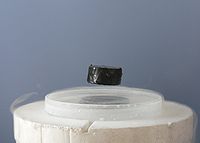
Photo from wikipedia
The polymer materials used in the injection molding process have a non-Newtonian characteristic. Consequently, a flow imbalance problem often occurs, even if an H-type runner system is employed. This problem… Click to show full abstract
The polymer materials used in the injection molding process have a non-Newtonian characteristic. Consequently, a flow imbalance problem often occurs, even if an H-type runner system is employed. This problem can be addressed by placing a static mixer in the runner. However, the performance of the mixer is highly dependent on its design. Accordingly, the present study employs the Taguchi design methodology to optimize four geometry parameters of the passive mixer, namely the baffle lattice angle (Factor A), the baffle lattice thickness (Factor B), the mixer length (Factor C) and the baffle inset pattern angles (Factor D). For each run in the orthogonal array, the temperature distribution at the mixer outlet is evaluated by Moldex3D simulations. The parameter settings which result in the maximum temperature uniformity [i.e., the maximum signal-to-noise (S/N) ratio] are then taken as the optimal design. The validity of the optimization results is confirmed by means of ANSYS Fluent and Image J simulations. The Taguchi results show that the optimal parameter settings for the passive mixer are as follows: lattice angle = 45° (A2); lattice thickness = 0.5 mm (B1); mixer length = 30 mm (C3); and inset pattern angles = 45°–45°–90° (D2). The Moldex3D simulation results show that the optimal mixer design improves the Taguchi S/N ratio by 1.17 dB compared to the original mixer design. Furthermore, the ANSYS Fluent simulations show that the mixing index is improved from 0.5121 (original design) to 0.4213 (optimal design).
Journal Title: Microsystem Technologies
Year Published: 2020
Link to full text (if available)
Share on Social Media: Sign Up to like & get
recommendations!